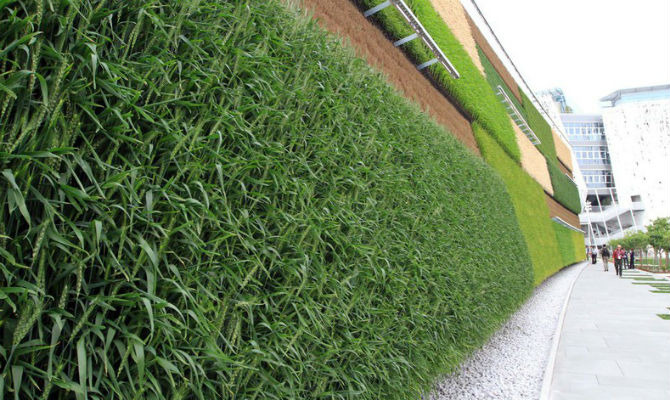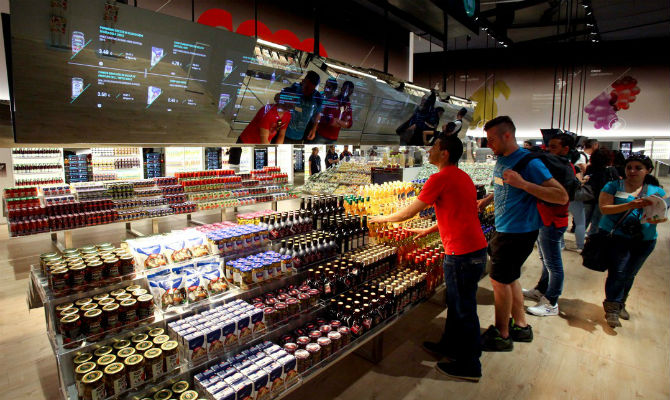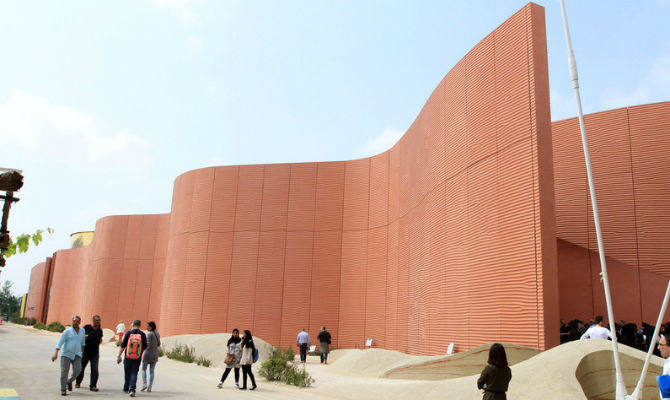Italy Throws A Great Party But Still Hasn't Found The Solution To World Hunger
Welcome to Expo Milano 2015, the latest world's fair focused entirely on food. With 1.1 million square meters of exhibition space, 145 participating countries, and an anticipated draw of 20 million visitors over its six-month run time, Expo Milano 2015 is probably the largest food event in history. The Expo's theme is "Feeding the Planet, Energy for Life." The goal of this massive worldwide collaboration is to showcase new technologies that can provide a concrete answer to one of the world's greatest concerns: how to "guarantee healthy, safe, and sufficient food for everyone, while respecting the planet and its equilibrium." However, the question is: has Expo Milano 2015 made any real headway towards its goal?
A few interesting pieces of technology that at least have potential to someday move the world closer to sustainably feeding all people can be seen at the Expo. Israel's pavilion, for example, is simply a giant curved wall made up of vertical fields, with a unique irrigation system produced in Israel. These ideas could potentially allow food producers to cultivate more crops with less water waste in smaller spaces. The outer walls of Italy's pavilion are made out of "biodynamic" concrete panels, an innovative new building material that removes some of the pollution from the air and transforms it into inert salts. Surely less pollution can only be a step forward towards a healthier Earth.
The Grocery Store of The Future, conceived by MIT professor Carlo Ratti, gives shoppers information about the origins of their food, its carbon footprint, nutrition facts, and more. Perhaps someday, with this information at their fingertips, consumers will make wiser food choices for themselves and the environment.
Other pavilions don't necessarily offer a direct solution to our world's food problems but are more of an installation work focused on building awareness about specific issues. The United Kingdom pavilion is one of the most interesting examples. The building is essentially a 56-foot aluminum beehive, which produces sound and movement based on the inner workings of an actual beehive located back in Nottingham. The installation is intended to raise awareness about the world's bees and how vital it is they are protected.
Switzerland's pavilion makes a fairly strong statement and is meant to help visitors reflect on their own consumption of scarce food resources. The building consists of four towers filled with Swiss food products like coffee, apples, water, and salt. Visitors can take as much of the food as they choose. The catch is that there is a limited amount of food in the towers, which will not be refilled for the duration of the Expo. When the food runs out, it runs out; meaning that overconsumption by early visitors to the pavilion could leave nothing for future visitors. An added bonus of the Swiss pavilion is that it is intended to be returned to Switzerland and used as greenhouses when the Expo is finished.
Overall, there seems to be a low level of focus on Expo Milano 2015's noble theme. Prime locations were given to some food vendors with less-than-healthy reputations, such as McDonald's, whereas the Slow Food movement displays were placed in a "back corner"-type location. Similarly, a large amount of space was given to industrial chocolate producer Lindt – while many people love a chocolate treat now and again, this focus doesn't necessarily seem to track with feeding the world healthfully.
Meanwhile, most participating countries seem to be primarily using the Expo as a chance to promote tourism, display their national heritage, and show off their country's food. Not bad goals necessarily, but it brings up the question: how exactly do you square the Expo's theme of sustainably feeding the world with the sheer excess, expense, and waste that is surely being produced by an event of this scale? Endless food choices for visitors sit next to expensive pavilions promoting countries that are having trouble, right now, adequately feeding their populations. Something just doesn't add up. It's enough of a disconnect to make you wish there was no theme at all and the Expo was presented for what it primarily is: a gigantic worldwide celebration and theme park for food.
When viewed as a party to show off the many fascinating cultures and rich food traditions of the world, the Expo can be considered a complete success. The participating countries, countless food producers, restaurants, and food organizations have been preparing for the event for several years, and it shows. Many of the elaborate pavilions are stunning works of architecture, which run the gamut from beautiful and artistic; to outrageously bright, decorative, and celebratory; to sleek, modern, and chock-full of showy interactive technology. The United Kingdom, Brazil, Italy, China, Germany, and United Arab Emirates pavilions are certainly worth seeing for their creative architecture alone.
Best of all, because this is a food-focused world's fair, you also can find something wonderful to eat from any and every country you've ever dreamed of visiting. There's plenty of food to eat on the go, as well: gelato from Italy, Belgian fries, tacos from Mexico, and so much more. Or if you want to take the time, you can sit down to a five-star meal from an internationally recognized chef at places like Peck, the James Beard House Restaurant, Identità Golose, or Café des Chefs.
So is attending the Expo just for the sake of having fun, exploring other cultures, enjoying the captivating architecture, and eating plenty of good food so terrible? Visitors to the Expo would most likely answer with a resounding, "No!" After all, humans are hard-wired to love a good party, and the Expo is most certainly the biggest one in town. On the other hand, did the Expo really give us "a concrete answer to a vital need"? Unfortunately, not really, in my opinion. Though some countries have managed to incorporate "Feeding the Planet, Energy for Life" into their displays, ask real questions, and demonstrate new technologies with potential, overall there is a lot more showmanship going on at the Expo than searching for real answers. For now, the world will still have to continue waiting and working towards our dream of a future where no one goes hungry.



